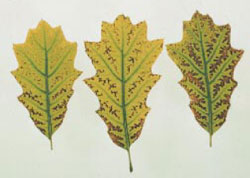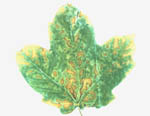Reports on Plant Diseases |
RPD No. 620 - Leaf Scorch of Woody Plants
|
June 1997
|
[ Symptoms ] [ Causes ] [ Control
] [ Susceptibility ]
|
Leaf scorch is a widespread noninfectious disease or disorder that may
occur on any species of tree or shrub. Woody plants commonly affected
in Illinois are listed in Table 1. Scorch is most
common follow-ing prolonged periods of dry, windy weather or bright sunshine
when the roots are unable to supply water to the foliage as rapidly as
it is lost through the leaves by transpiration. Injury also is most common
where plants are growing in an unfavorable location, such as in sandy
or gravelly soil, near obstructions or pavement that restricts the area
for root growth, or on an exposed windy slope. In fact, leaf scorch may
occur each year in such unfavorable locations, or when injury to a part
of the root system is permanent and severe, regardless of weather, adequate
soil moisture, or other conditions.
|
Click on image
for larger version

Figure 1.
Leaf scorch on red oak
(D.F. Schoeneweiss).
|
In mild cases of leaf scorch, the leaves remain attached, and little damage
results. In more severe cases, plants may drop many of their leaves prema-turely,
although such plants do not die. Where leaf scorch occurs each year, such perennial
stress will gradually weaken the plant, making it more susceptible to opportunistic
pathogens, to attack by secondary insects, to injury by severe winter weather,
and to other environmental problems.
Symptoms
|
Click
on image for larger version

Figure 2. Leaf
scorch on maple
(W.E. Clark photo).
|
Scorch usually develops on broad-leaved plants as an irregular
yellowing, browning, or bronzing of tissues between the veins or along
the margins and tips of leaves (Figures 1 and 2). These leaf areas are
the last to receive water from the roots; therefore, they are the first
to show scorch symptoms. All the leaves on a branch are generally more
or less uniformly affected. As the season progresses, affected leaves
may turn entirely brown and wither. If scorch is severe, shoots may
die back, and the foliage may appear black and burnt. The most severe
symptoms appear when scorch occurs as tender new leaves emerge from
the bud in early spring.
|
Narrow-leaved evergreens, such as arborvitae, fir, hemlock, pine, spruce, and
yew, express leaf scorch as a brown or purple brown discoloration of the needle
tips. When scorch is severe, half or all of a needle may turn brown. Scorch
injury on narrow-leaved evergreens may result from hot, dry weather in summer
or from strong, dry winds when the soil is frozen. Symptoms may not become apparent
for a month or longer after initial injury occurs.
The position of the leaves most severely affected by scorch can often be used
to distinguish this disorder from such infectious diseases as leaf spot, blight,
or anthracnose. Scorch-damaged leaves are usually most abundant on the side
of a tree or shrub that is exposed to prevailing winds and excessive sunlight.
Leaves blighted from fungus infection are usually scattered throughout the top
and are usually most infected on the lower, more densely shaded parts. In addition,
the majority of foliar infections caused by fungi occur under warm, moist conditions.
Back to Top
Causes
Leaf scorch may be induced by internal physiological disturbances; a nutrient
deficiency; transplant shock; fastidious xylem-inhabiting bacteria; unfavorable
weather conditions, such as low temperatures, high winds during cold or hot
weather, excess water or drought; girdling roots; soil area too restricted for
good growth or a paved surface over the roots; shallow, compacted, or poor soils;
a change in the soil grade or an altered water table; toxic concentrations of
one or more chemicals (e.g., deicing salt, fertilizer, or pesticide); air pollutants;
root destruction from nearby construction work (e.g., from constructing buildings,
digging utility trenches, or installing curbs or sidewalks); heavy infestations
of sucking or boring insects; nematode, insect, or rodent damage to the roots;
a diseased root system; wood rot; wilt disease; and large girdling cankers.
Back to Top
Control
Scorch is usually less severe on trees and shrubs well adapted to the area.
Any practice that promotes root development and improves general plant health
will aid in reducing leaf scorch. Although the affected leaves will always show
symptoms, new foliar growth may escape scorching if the control measures outlined
below are followed.
- Woody plants should be planted in a fertile, well-drained soil at the same
depth the plants grew in the nursery and with an adequate supply of organic
matter. The planting hole should be dug two to three feet wider and a foot
deeper than the root ball to prevent crowding. Avoid planting shock by pruning
back branches by about one-third if this was not already done at the nursery.
- Thoroughly water plants low in vigor, especially during periods of drought.
The soil should be moist to a depth of 10 to 12 inches following irrigation.
It is critical to supply at least an inch of water per week (900 gallons for
a 30- by 50-foot area) to recently transplanted trees and shrubs during dry
periods. A slow soaking of the soil is usually most effective. Feeding lances
or needles are a convenient means of soaking the soil around the roots.
- Fertilize woody plants based on a soil test and the directions printed on
the fertilizer container. The soil pH, available phosphorus (P ), potash,
and micronutrients should be adjusted to optimal levels 1 for plant growth.
Nitrogen should be applied annually based on the area to be fertilized, the
type of plant, and the diameter of the trunk. Usually it is best to fertilize
in early spring or late fall.
- Prune the tops of plants with restricted or reduced root systems to (a)
reduce the amount of water that must be supplied by the roots and (b) obtain
a better balance between top and roots. Light general pruning of deciduous
trees and shrubs is recommended to help reduce the total foliage load that
must be supported by the root system. Dead, dying, crossing and interfering
branches should also be removed.
- Where the soil is heavy and compacted, some improvement will result from
mechanically loosening the surface layers of soil or from inserting a series
of upright agricultural tiles, which will permit water to penetrate more rapidly
and in greater amounts.
- The installation of drain tiles also will be beneficial where scorch results
from the inability of roots to absorb water because of excessively wet soils,
or where the roots are buried by a soil fill. Serious root damage caused by
deep or compacted fill soil cannot be corrected.
- Leaf scorch in very valuable trees – especially broad-leaved evergreens
– can be prevented, or at least reduced, by spraying the foliage with an antitranspirant
before the regular summer or winter "scorching period" is expected. Carefully
follow manufacturer's directions when using any product.
- The browning and drying of evergreen foliage in winter can be avoided to
some extent by watering the trees and shrubs thoroughly during summer droughts
and in late autumn and by adding several inches of an organic mulch (e.g.,
sawdust, wood chips or shavings, salt hay, ground corncobs, pine needles,
or oak leaves) over the root zone after watering. In winter, the mulch will
prevent deep freezing or alternate freezing and thawing of the soil; in hot
weather, the mulch will keep the soil cool.
- Small evergreen trees and shrubs growing in exposed locations, especially
broad-leaved plants, can be protected from direct sunlight and drying winds
during the winter months by erecting a lath, cheesecloth, canvas, or burlap
screen. Place the screen two feet away from the plant on the south and southwest
sides. Better still, grow these plants in a more protected location.
- Scorch due to exposure from such things as excessive fertilizer, deicing
salt, herbicide, dog urine, trash fires, leaking sewer or gas mains, girdling
roots or strangling wires, vehicle exhaust, and heat reflected from buildings
or pavement can be prevented only by removing or avoiding the specific cause
or causes.
- Avoid root injury when digging near trees and shrubs. When roots must be
cut, reduce top growth to obtain the proper top-to-roots ratio.
- Check for root, trunk, or branch diseases – especially large cankers, a
vascular wilt, or root rot. All of these diseases can produce leaf scorch
symptoms. Removal of a limb or the entire plant may be necessary.
| Table 1. Woody Plants Grown in Illinois That Are Commonly
Affected by Leaf Scorch |
| Alder |
Golden-chain |
Plane tree, London |
| Almond |
Gooseberry |
Plum |
| Apple |
Hackberry |
Poplar |
| Arborvitae |
Hawthorn |
Privet |
| Ash |
Hemlock |
Quince |
| Aspen |
Hickory |
Quince, flowering |
| Barberry |
Holly |
Redbud |
| Basswood |
Honeylocust |
Redwood, dawn |
| Beautybush |
Honeysuckle |
Rhododendron or Azalea |
| Beech |
Hop hornbeam |
Rose |
| Birch |
Hornbeam |
Russian olive |
| Blueberry |
Horse chestnut or Buckeye |
Sassafras |
| Boxelder |
Hydrangea |
Serviceberry |
| Boxwood |
Juniper |
Siberian pea tree |
| Buckthorn |
Katsura tree |
Smoke tree |
| Buttonbush |
Larch |
Snowberry |
| Catalpa |
Lilac |
Sour gum |
| Cedar |
Linden |
Sourwood |
| Cherry |
Locust, black |
Spirea |
| Coffee tree, Kentucky |
Magnolia |
Spruce |
| Cork tree, Amur |
Mahonia |
Sumac |
| Cotoneaster |
Maple |
Sweet gum |
| Cottonwood |
Mimosa or Judas tree |
Sycamore |
| Crabapple |
Mock orange |
Tree of heaven |
| Cranberry bush |
Mountain ash |
Tulip tree |
| Currant |
Mulberry |
Virginia creeper |
| Dogwood |
Ninebark |
Walnut |
| Douglas fir |
Oak |
Wayfaring tree |
| Elderberry |
Pagoda tree, Japanese |
Willow |
| Elm |
Peach |
Wisteria |
| Fir |
Pear |
Witch hazel |
| Firethorn |
Pecan |
Yew |
| Forsythia |
Pine |
Zelkova |
| Ginkgo |
|
|
For further information on diseases of turf and ornamental plants, contact
Nancy R. Pataky, Extension Specialist and Director of the Plant Clinic, Department
of Crop Sciences, University of Illinois at Urbana.
Back to Top
|



